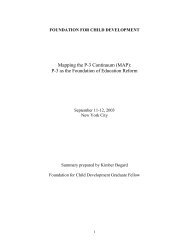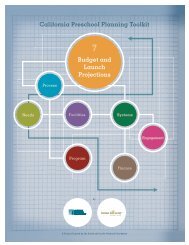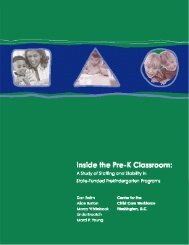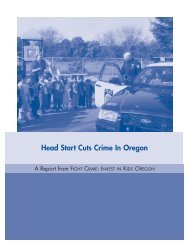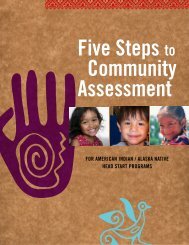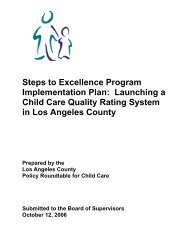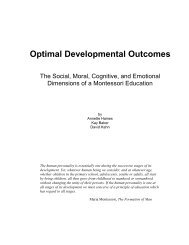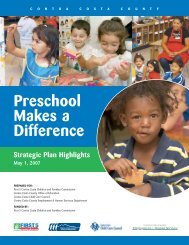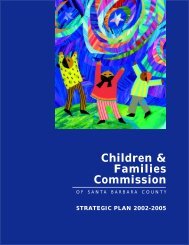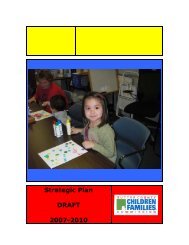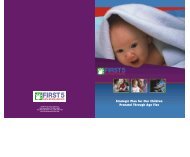Download this file - Plan4Preschool
Download this file - Plan4Preschool
Download this file - Plan4Preschool
Create successful ePaper yourself
Turn your PDF publications into a flip-book with our unique Google optimized e-Paper software.
intended to have low student-teacher ratios. Students benefit from learning support<br />
services that include school counselors and psychologists, academic and vocational<br />
counselors, and pupil discipline personnel. Students also receive collaborative services<br />
from county offices of education, law enforcement, probation, and human services<br />
agency personnel who work with at-risk youths. CDSs are supported by supplemental<br />
apportionments for CDS attendance, in addition to base revenue funding. The laws<br />
specific to CDSs are in California Education Code (EC) sections 48660—48667. More<br />
information is available on the CDE Community Day Schools Web site at<br />
http://www.cde.ca.gov/sp/eo/cd and at the Community Day Schools Network Web site<br />
at http://www.cdsnetwork.org.<br />
In October 2005, the California Basic Educational Data System (CBEDS) reported that<br />
244 districts and 17 county offices of education operated CDSs. While CBEDS shows<br />
that 11,182 students were enrolled in 338 CDSs on the reporting day, there is a<br />
significant turnover in CDS students as they transition in and out of CDSs throughout<br />
the year. Approximately 30,000 students actually were served in CDSs during the<br />
200-06 school year. Also, the number of CDSs continues to grow. Approximately 370<br />
CDSs are expected to be in operation during the 2006-07 school year.<br />
Continuation Education<br />
Continuation education, an educational option for students since 1919, is a high school<br />
diploma program to meet the needs of students sixteen through eighteen years of age<br />
who have not graduated from high school, are not exempt from compulsory school<br />
attendance, and are deemed at risk of not completing their schooling. The Model<br />
Continuation High School Recognition program is a partnership between the California<br />
Department of Education and the California Continuation Education Association that<br />
identifies outstanding schools and creates a list of quality programs for school<br />
visitations.<br />
Students enrolled in continuation education programs are often credit deficient. They<br />
may need a flexible educational environment because they are employed or fulfilling<br />
family obligations. An attendance day is 180 minutes. However, many continuation high<br />
school programs provide a wide spectrum of courses that exceed the minimum daily<br />
requirement. In addition to academic courses, the program emphasizes an occupational<br />
or a career orientation or a work-study schedule. Supplemental programs may include<br />
independent study, regional occupational programs, career counseling, and job<br />
placement and apprenticeship programs. In October 2005 there were 525 continuation<br />
high schools reporting an enrollment of 69,601.<br />
County Community Schools<br />
County community schools are operated by county offices of education to serve<br />
students who are expelled from their regular schools, who are referred by a School<br />
Attendance Review Board or at the request of the pupil’s parent or guardian, who are<br />
referred by probation (pursuant to sections 300, 601, 602, 654 of the Welfare and<br />
110



